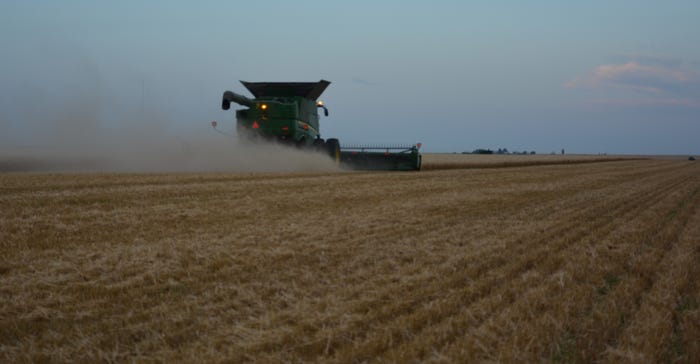
Louise Ehmke chatted with other customers at the Scott City elevator as she waited her turn for a protein test on a sample of wheat.
Trucks rolled steadily across the scales of the elevator on a hot, humid July night, keeping the operator busy running moisture and test weight samples. One driver turned away disappointed when the readout said 18% moisture and 51 pounds test weight.
“I guess I’m headed back home with this,” he said before the elevator manager stepped in and told him to go ahead and dump his farm truck.
“We’re putting the wetter, low-weight stuff in the bin with the fans,” he said. “We’re piling the dry grain on the ground for now.”
Ehmke was happy with her moisture and test weight readings — 12% moisture and 63 pounds test weight. She was prepared for bad news on the protein front, having already had tests with disappointing results.
“It’s just been a tough year,” she said.
But, for this test of a field of T158, there was good news. Protein was 12.5%. She quickly called home with the news. This field, yielding between 60 and 65 bushels per acre, was a “keeper,” and trucks could head to on-farm storage to unload.
A field cut the day before yielded around 80 bushels per acre, but protein was around 11%.
“We are keeping everything over 12% because, with so much of this year’s crop being low on protein, I think there’s a good chance we can sell for a premium down the road,” said Vance Ehmke, who has ample on-farm storage as part of his seed business.
It has been a tough year for Kansas farmers, though in many areas wheat has benefitted from a long, wet spring, which is conducive to good yields.
“This is the sixth year of more rain than usual,” Vance Ehmke said. “I know from experience that unusually wet weather is followed by unusually dry weather. In the past, we haven’t had more than three years in a row of exceptional moisture. I’m very worried about what kind of drought we will see following this pattern.”
Even as a second custom cutting crew was arriving to help harvest wheat, Vance Ehmke was preparing to plant soybeans and grain sorghum.
He said he has moved to minimum till rather than no-till, using an undercutter to eliminate stubborn weeds, including herbicide resistant kochia
“It’s just horrible around here,” he said. “People trying to stick with no-till are just not keeping it under control. There are fields that it will be hard to even harvest because the kochia has just taken over the field.”
As rainy weather continued into July, farmers were taking advantage of whatever time they could to bring in the wheat harvest. The USDA Crop Progress report for the week of July 7 showed harvest at 61% complete, well behind the average of 98% for that timeframe.
Some fields in the northern tier of counties are still green, but hot dry weather in mid-July was pushing harvest rapidly forward.
About the Author(s)
You May Also Like






